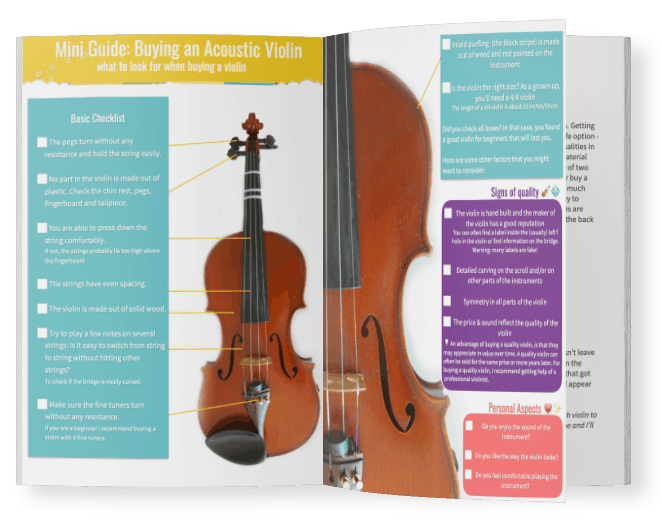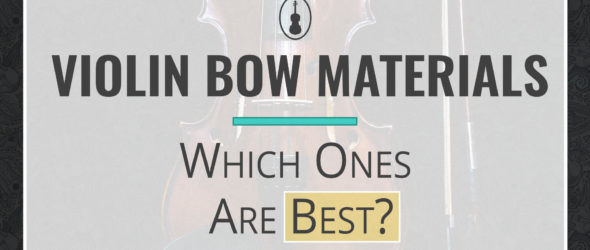You may have heard that the material of a violin bow stick has the biggest influence on the quality of the bow!
The quality of your tone production can rely as much as 30% on the bow. So no matter if you are a professional or an amateur violinist, choosing the right bow is vital.
But how do you know what are the violin bow materials and which violin bow material is best for your particular needs and budget?
The process of choosing the right bow can seem daunting, but it doesn’t have to be! I’m going to break down the different types of materials used for bows as well as discuss their pros and cons so that you can find the perfect match for your playing style.
Violin Bow Materials: Composite Materials
Fiberglass Violin Bows
Most inexpensive violin bows are made from fiberglass. Fiberglass is a material made from a mix of plastic and glass fibres. Often this type of bow is hollow on the inside.
If you ever got an inexpensive violin bundle, in which the bow was included, you most likely own a fiberglass bow.
Fiberglass bows are solid bows that do not easily break. However, it can be difficult to get a beautiful tone out of this type of bow. Because of the uneven weight division, it can be very difficult to draw smooth sounding whole bow strokes or do string changes. On most fiberglass bows more advanced techniques in which the bow naturally bounces, such as spiccato, ricochet or sautillé, are very difficult or even downright impossible to perform correctly.
That is why I do not recommend getting a fiberglass bow, unless budget is your main decisive factor in purchasing and you want to go for the cheapest option.
In the last case, don’t pay too much for this type of bow. You can easily get one for around 40 USD. You can find them even cheaper second hand, as many beginning players that quit or move on to an intermediate level sell their old fiberglass bow.
Pros of Fiberglass Bows
- Cheapest option available
- Easy to find violin package deals with this blow included
Cons of Fiberglass Bows
- Quality of tone is lacking
- Hard to draw a smooth and straight bow stroke
- Can not be used for intermediate and advanced bowing techniques
Carbon Fiber Violin Bows
Carbon Fiber bound with plastic polymer resin is extremely strong, durable and flexible. That makes for the perfect attributes of a violin bow.
Carbon fiber bows have not been around for nearly as long as wooden bows, but they are quickly gaining popularity among both amateur and professional players.
One of the reasons for this is that you can get more bang for your buck when choosing a carbon fiber bow. In comparison, carbon fiber bows are less expensive than wooden bows of the same quality.
Carbon fiber bows are the best option for you if you live in an extreme climate and still want to use a quality bow. Wooden bows are susceptible to changes in humidity and heat, while carbon fiber bows can easily handle any extreme climates.
Pros of Carbon Fiber Bows
- Great for young students as it is not easily breakable
- Great price – quality ratio, especially below $1000
- The manufacturing method makes each bow predictably consistent in quality
- High quality carbon fiber bows are manufactured to make it easier to play all bow strokes, including off-string strokes such as spiccato
- It is the strongest bowing material currently available
Cons of Carbon Fiber Bows
- Cheap carbon fiber bows can be very low quality – be careful to select a respected manufacturer
- The highest quality handmade wooden bows can outperform carbon fiber bows in the warmth and depth of the tone
- Mass manufactured. From a price range of 1000 and up, you can also get high quality handmade bows
- For seasoned violinists that are used to a wooden bow, it can take some time to get used to this type of bow as they are lighter and balanced differently
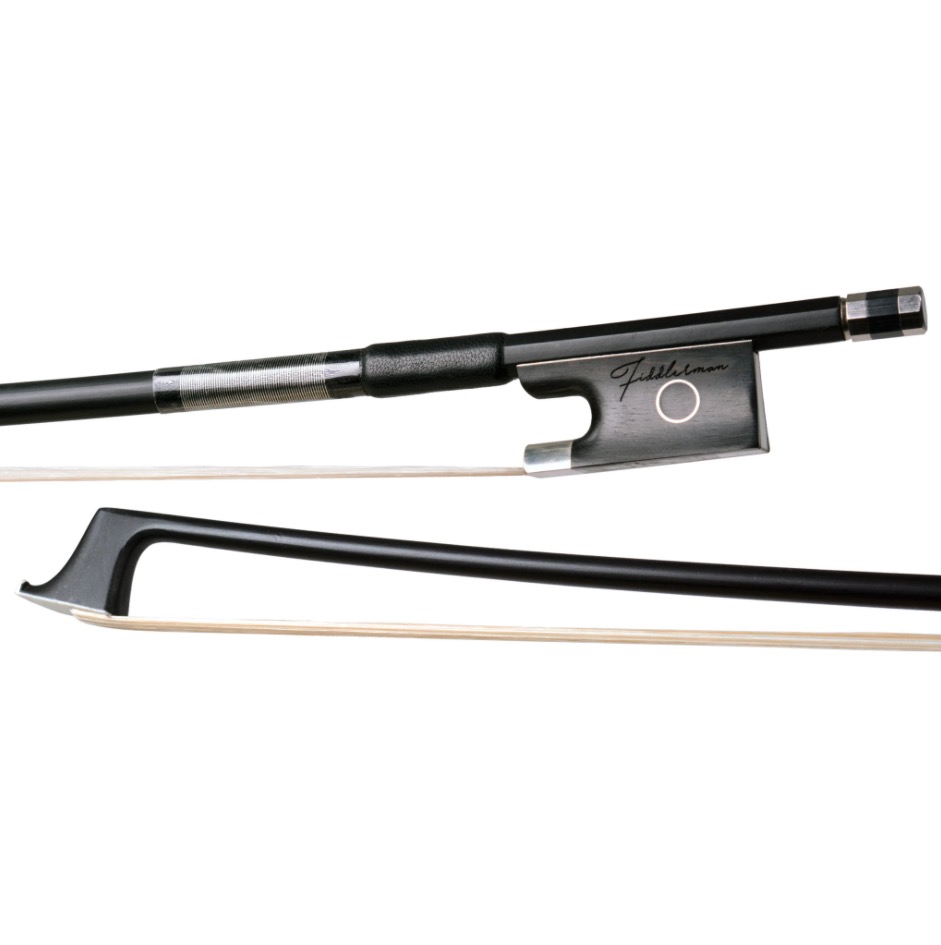
Fiddlerman Carbon Fiber Violin Bow
GET IT NOW
Support us for more FREE content No extra costs for you Recommended by Violinists
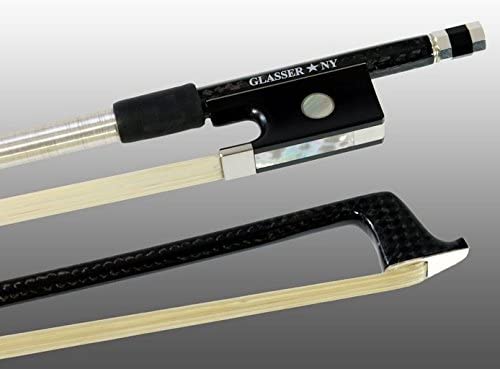
Glasser – Braided Carbon Fiber – Violin Bow 4/4 Size
GET IT NOW
Support us for more FREE content No extra costs for you Recommended by Violinists
Violin Bow Materials: Wood
Pernambuco Violin Bows
Pernambuco wood is traditionally seen as the world’s best quality wood for bow-making.
For the best pernambuco bows, the heartwood of the Pernambuco tree is used. Heartwood is wood nearer the pith of a stem or branch, different in colour from sapwood. This wood forms the spine of the tree and is both very strong and durable.
There are cheap pernambuco bows on the market that are made from the cheaper sapwood of the tree, which does not resemble the quality of heartwood. There are also pernambuco trees that are not harvested in the original pernambuco region, but in other regions in China, that are said to have a lesser quality wood.
Even though the sound of this type of bow is very beautiful, many violinists do not want to buy pernambuco bows anymore for ethical, practical, and budget considerations.
The pernambuco tree is now an endangered tree and is forbidden from being cut. Most pernambuco wood on the market today is harvested illegally and endangers not only plants and trees, but also animal species in the rainforest.
It also is considered impractical to own a Pernumbuco bow, especially if you want to take your violin bow on holidays. As the import of endangered species is restricted, you might not be able to take your bow with you – or even worse, you might have to leave it behind in another country on your flight back.
If more violinists would use bows made from synthetic materials and alternate woods, there would be less pressure on Pernambuco. That is why today, many violinists go for quality bows made from other materials.
Another reason why Pernumbuco is becoming less and less popular is the price to quality ratio. Since the Pernumbuco tree got endangered, prices of the wood have gone up immensely. That is why even low quality bows are highly priced. Especially in the lower price-range, Pernumbuco or even other handmade wooden bows do not compare to carbon fiber bows.
If you decide to go for a Pernambuco bow, make sure that it is an original, second hand bow that has been created before environmental restrictions. Newly harvested Pernambuco wood is controversial and enlarges problems of deforestation.
You can normally find this type of bow in shops of violin makers that buy, touch up and resell old instruments. You can also find them second hand and pre-owned.
Pros of Pernambuco
- The highest quality pernambuco bows are considered to be the best bows in the world
- Unique, handmade bow
- Can be a financial investment, especially if the quality is very high and/or the maker is renowned
Cons of Pernambuco
- Risky to travel with this bow as importing of endangered materials is restricted – you might get into trouble travelling back to your home country with a pernambuco bow
- Fragile compared to carbon fiber bows
- Price – quality ratio is not optimal, as the material is scarce. Prices can run up very high even for lower quality bows
- Easy to misbuy – there are many low quality pernambuco bows on the market. Only an expert can distinguish high quality from low quality pernambuco bows
- Unsustainably harvested. When buying a new bow in which pernambuco materials are used, you will most probably contribute to further deforestation of the rainforest
Brazilwood Violin Bows
Bows made of brazilwood have almost as much resilience and strength as do pernambuco bows, but they’re more affordable. There’s a price difference because the wood is very similar to, but not quite as fine as pernambuco.
There are some low quality brazilwood bows on the market, but normally you can easily spot them as they have unreasonably low prices.
In the following picture you can see what a brazilwood bow looks like:
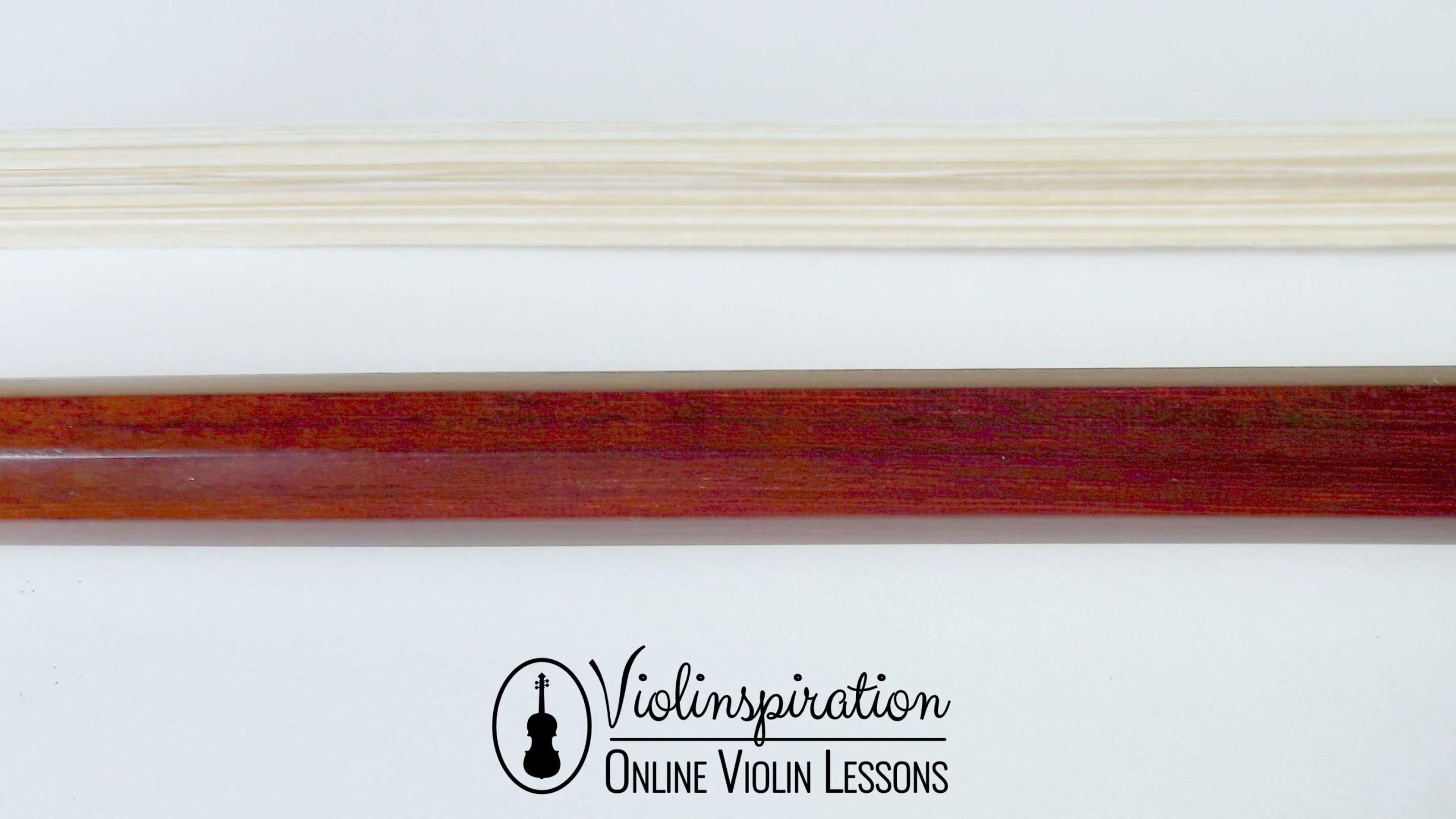
Pros of Brazilwood
- A sustainable wooden bow that can be imported to any country
- You can get great handmade quality, especially in higher price ranges
Cons of Brazilwood
- Fragile compared to carbon fiber bows
- The price-quality ratio for bows under 1000 dollars is usually worse than that of carbon fiber bows
When you’re looking for a wooden bow, make sure to check carefully the origin of the wood as sometimes “Pernambuco” and “Brazilwood” are used interchangeably while they don’t necessarily mean the same wood. If you want to be sure that you’re not buying a bow from an endangered species, I recommend you snakewood or a carbon fiber bow.
Snakewood Violin Bows
Real snakewood is very heavy and stiff – the wood is even denser than pernambuco.
Snakewood is often preferred by baroque violinists, as the sound of the bows on the strings is considered softer and more subtle.
Some violinists experience that snakewood bows are a little less elastic than pernambuco bows. However, a bow made from high quality snakewood can be of better quality than a low quality pernambuco bow. This can only be tested with trial and error.
Pros of Snakewood
- Softer sound can be excellent for baroque violinists
- Sustainable wooden bow that can be imported to any country
- You can get an great handmade quality, especially in higher price range
Cons of Snakewood
- Fragile compared to carbon fiber bows
- The price-quality ratio for bows under a 1000 dollars is usually worse than that of carbon fiber bows
Other types of wooden bows
Since pernambuco became an endangered tree, violin makers all over the world experimented with many types of wood. Even though snakewood and brazilwood are currently some of the most common woods used for violin bows, there are violin bows made from all types of wood available.
Hybrid Violin Bows
Hybrid bows are made with a strong carbon fiber core that are wrapped with a wooden skin. It looks like a wooden bow but is considered stronger because of the carbon fiber core.
Hybrid violin bows usually have a slightly warmer sound than carbon fiber bows.
Pros of hybrid bows
- Stronger than a usual wooden bow due to the carbon core
- Can have a warm sound compared to usual carbon fiber bows
Cons of hybrid bows
- If the wrapping is made with pernambuco, the cons of pernambuco apply, such as deforestation of the rainforest and problems with travelling with your violin
- It is harder to produce than a regular carbon fiber bow, which in many cases makes the price-quality ratio drop
The Violin Bow Materials are Not The Only Factor
Even though the violin bow material is one of the factors that decides how a violin will sound, in the end the most important thing is how the bow feels and plays for the players.
That is why testing different bows on your instrument is the best way to figure out what bow works for you.
Here are some things to look for in a bow:
- The elasticity. Bendable bows do not crack easily.
- How easily does the bow bounce for bouncing bow strokes such as spiccato? When using a good bow, you do not have to put much effort into bouncing the bow.
- Heaviness at the tip. The tip should not feel too heavy nor too light.
- The balance point of the bow. It should not be too far away from the frog. For comparison, the balance point of my bow is 25 cm from the end of the stick.
Some of these factors are very difficult to feel as a beginning player. In this stage, most players are not sure yet how heavy a bow feels.
That is why, in case of doubt, you might like to have a look at carbon fiber bows. This type of bow can be more easily mass-produced in a similar quality.
Alternatively, it can be very much worth it to ask a local teacher to help you in finding a good violin bow for you. By paying the teacher for her or his time to browse around in local violin shops, you can get help from a professional in testing different violin bows.
If visiting a shop that offers violin bows isn’t possible for you, make sure to have a look at my recommendations chosen from the online bow sellers.
